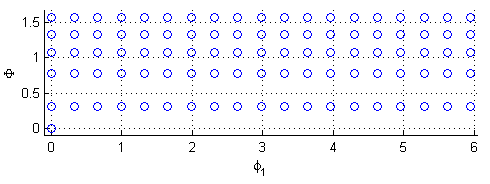MKS Calibration and Validation for Realistic Microstructures
MKS Calibration and Validation with a Variety of Microstructures
The purpose of this effort was to benchmark the MKS in the prediction of LE strain fields for a variety of calibration and validation microstructures. All properties used are for the $ \alpha $ -Ti materials system. The ABAQUS FEM solver was used for all simulation results.
Random, Delta, and Equiaxed microstructures were chosen for this effort as described below:
Random: Each voxel in the microstructure is randomly assigned an orientation
Delta: The center voxel of the microstructure is assigned one orientation and the remaining voxels are assigned another orientation.
Equiaxed: A microstructure with a realistic grain structure as generated by Dream3D where an orientation is randomly assigned to each grain
For the calibration microstructures orientations were selected from the $ \phi_2 = 0 $ face of the hexagonal triclinic fundamental zone ( $ 0 \leq \phi_1 \leq 2\pi, 0 \leq \Phi < \frac{\pi}{2}, 0 \leq \phi_2 \leq \frac{\pi}{3} $ ). These orientations are shown in the following image:
Orientations for the validation microstructures were randomly assigned from a set of 4800 orientations in the hexagonal triclinic fundamental zone.
The following chart shows the errors associated with each combination of 100 calibration simulations and 25 validation simulations:
The following image shows the predicted strain fields for a slice of a realistic microstructure, where 100 delta microstructures are used for calibration:
The image below shows the predicted strain field for an example delta microstructure:
Dependence of Validation Accuracy on Calibration Orientation Set
In this effort calibration orientations were again selected from the $ \phi_2 = 0 $ face of the hexagonal triclinic fundamental zone. In Set 1 these orientations spanned the entire face except that only one orientation was selected from the $ \Phi = 0 $ edge. In Set 2 however, orientations from the $ \phi_2 = 2\pi $ edge are omitted.
The following image shows the selected orientations for Set 1
The following image shows the selected orientations for Set 2
In this trial 100 random microstructures were used for calibration and 25 equiaxed microstructures were used for validation.
The following chart shows the errors associated with calibrations for both sets:
MKS Validation for Textured Microstructures
In this trial strain fields were predicted for a set of 100 realistic Dream3D microstructures with a strong basal texture. 200 random microstructures with random texture were used to calibrate the influence coefficients. Matthew Priddy generated the microstructures and Noah Paulson performed the LE ABAQUS FEM simulations.
The MKS predicted the strain fields for the strongly textured validation microstructures with 0.198% mean error, 1.311% mean maximum error, and 2.187% absolute maximum error.
The following image shows the MKS predicted strain field for a slice of a strongly textured realistic microstructure:






